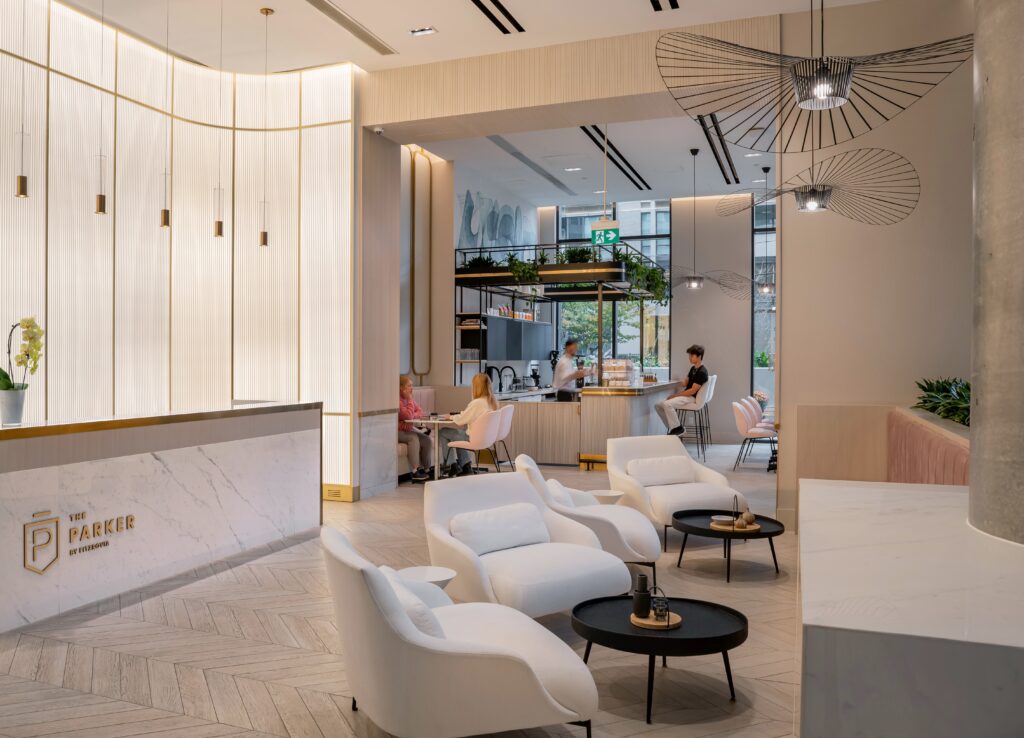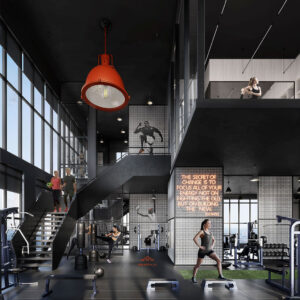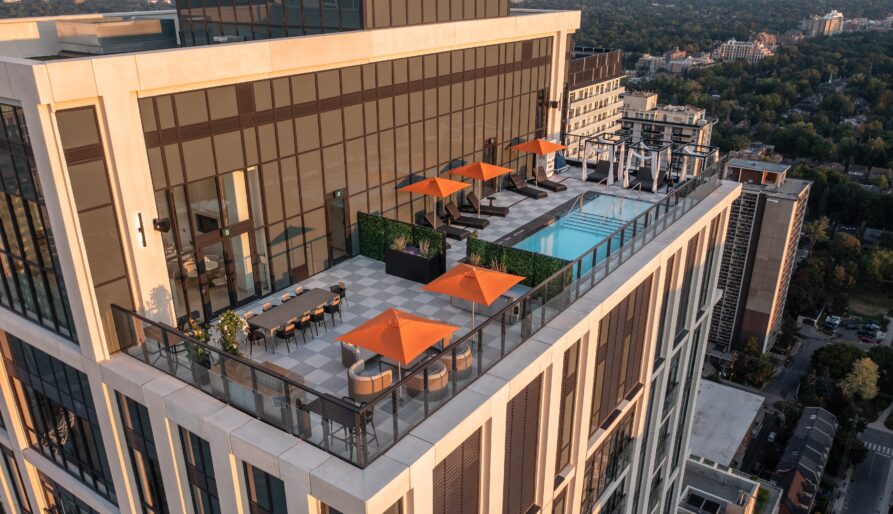Canadian design firm Figure3 believes that people and places should be connected. As such, when it sets out to design a new purpose-built rental development, the location and needs of the future residents are woven into a unique vision for that site and that site only. The result? An aesthetically pleasing yet functional living space where residents can relax, play, work, shop, and immerse themselves in the surrounding community.
Take the recently-opened “Parker” in midtown Toronto. Inspired by the luxury hotels of Iceland, the interior features pale, silvery-blonde woods paired with concrete and black metal accents. Simple yet elegant, the Nordic motif was chosen strategically by Figure3 for its apt reflection of the Yonge & Eglinton vibe, an area rife with urban professionals known to take their health, and coffee, seriously.
“The idea of street presence and putting the community on display is key for a purpose-built rental building,” said Dominic De Freitas, Principle at Figure3. “So, understanding the values and attributes of the neighbourhood becomes a critical part of the design process. It’s that connection to the streetscape that helps define the brand, and we as designers must harness that energy and translate it into the physical space.”
 From its double-height ceiling to its direct access to retail shops, the lobby at the Parker creates an inviting space for residents and passersby alike. Meanwhile, functional furniture groupings help to further define the zones and encourage connection among friends and neighbours.
From its double-height ceiling to its direct access to retail shops, the lobby at the Parker creates an inviting space for residents and passersby alike. Meanwhile, functional furniture groupings help to further define the zones and encourage connection among friends and neighbours.
“People attract people,” said De Freitas. “So, by bringing the social element to the entry experience, the curb appeal is amplified. It also creates social opportunities, which ultimately draw people into the space.”
Of course, that is the job of curb appeal—to draw people in. While traditionally this may have been achievable through fresh paint and potted flowers, purpose-built rental buildings today are pushing the boundaries of what curb appeal entails.
“In contrast to how rental lobbies were laid out in the past (bare and transient), we’re now activating the lobby to act as a community hub, designed for connection and convenience,” De Freitas said. “It’s about finding good tenants who will bring in other good tenants, and creating a brand and community that can, and should, be shared.”
Hence why everything at the Parker was chosen with intent. With its plush seating, rich textiles, and strategic lobby lighting, the communal space was designed to influence desired behaviours and reinforce the idea that “home” isn’t just confined to the suite; it’s the whole building.
The rise of brand collaborations
While apartment buildings used to be approached with a ‘one-size-fits-all’ mentality, times have changed, and more purpose-built rentals are now being marketed for their unique brand identities. Brand collaborations and on-site programming have become popular ‘add-value’ features, and according to De Freitas, this means understanding the needs of the target market and then creating experiences that amplify that lifestyle.
“Renting is no longer just a transitional step towards home ownership,” he said. “As cost continues to rise, creating a long-term resident relationship is key, and developers are leveraging brand recognition and increasing value-adds like never before.”
 At the Parker, residents can make use of a rooftop pool and a lofty, two-storey gym known as “The Temple”. (“Fuel your workout with a Greenhouse cold-pressed juice or kombucha,” the Parker website declares. “The Temple’s dedicated Greenhouse vending machine offers organic, non-GMO, plant-based beverages at discounted rates for residents.”)
At the Parker, residents can make use of a rooftop pool and a lofty, two-storey gym known as “The Temple”. (“Fuel your workout with a Greenhouse cold-pressed juice or kombucha,” the Parker website declares. “The Temple’s dedicated Greenhouse vending machine offers organic, non-GMO, plant-based beverages at discounted rates for residents.”)
Other popular amenities include a separate yoga sanctuary and spin studio, an arcade, a billiards room, two bowling alleys, a pet spa, a two-storey sky lounge and a children’s playroom containing a custom tree playhouse. But all these add-ons aside, DeFreitas said Figure3 still approaches its purpose-built rental projects with a classic design to ensure longevity and versatility for residents.
“Now more than ever, we must consider multi-generational audiences when designing for the high-rise rental community,” he said. “Renting is no longer just a viable option for young professionals, but also for families straight through to empty nesters, all who are seeking the ease of upkeep and elevated, hotel-like lifestyle.”
Condo vs. apartment: digging into the differences
Whether it’s a condominium or a rental development, at the end of the day, both asset types serve the same purpose: to provide a safe, comfortable living space for families and individuals. But how they are approached, according to De Freitas, is not the same at all.
“For a purpose-built rental project, this is a long-term investment on behalf of the developer—an asset they could potentially own for decades—whereas a condo developer will ultimately sell the units and transfer ownership relatively quickly.”
This distinction means there are nuances in the floorplans, material selection, and functionality that must be considered at the onset.
“Everything from the design to the marketing approach must be versatile, inclusive and appeal to each of these vastly different groups in a lasting way,” said De Freitas. “The idea that home ownership is the ‘ultimate and only’ option is going by the wayside, as stereotypes of rentals and renters are deconstructed. Renting is now seen as a convenient way to achieve greater flexibility in the long run.”
Additionally, pandemic-life has influenced people’s priorities regarding where and how they work and play. There is an increased demand for outdoor space, adaptable amenities, and convenience as more people opt to remain in one location.
“With remote and hybrid work culture likely here to stay, the importance of multi-functional gathering spaces as well as fully equipped co-working spaces has become even more important,” he said. “There is also a greater demand for compartmentalized zones that allow for private calls or video meetings. People are spending more time in the vertical community. They aren’t leaving the building as often but still may desire a change of scenery with the added comforts of home.”
According to De Freitas, units designed specifically with families in mind will be significant in terms of how rental buildings are designed in the future: “Currently, these larger units are often cost prohibitive,” he said. “The City of Toronto is looking at ways to incentivize developers and landlords to build family-sized units, and consider amenity spaces, such as on-site daycares and play areas.”
But ultimately what people want today will continue to drive the buildings of tomorrow—purpose-built rentals that put comfort, convenience, and community first.
FInd out more about Figure3’s upcoming rental projects at: Figure3.com





